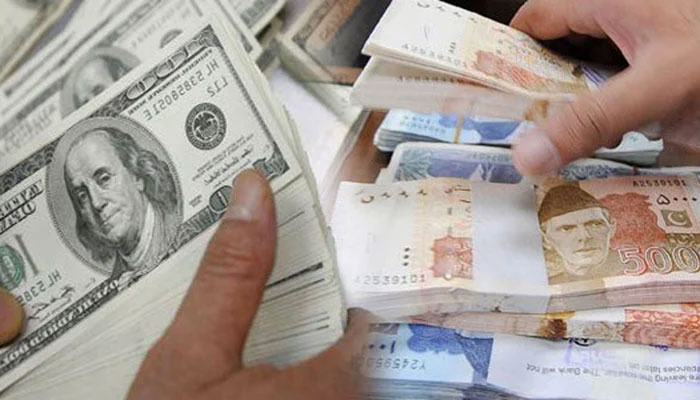Rupee drops to 262.6 against dollar
The rupee hit yet another record low although the drop was slowed as the IMF said that its team would be visiting Islamabad the next week to negotiate to resume a stalled bailout programme
KARACHI: The rupee hit yet another record low on Friday, although the drop was slowed as the IMF said that its team would be visiting Islamabad the next week to negotiate to resume a stalled bailout programme.
The local currency dropped 2.73 percent or 7.17 rupees, according to the central bank, to close at 262.6 to the dollar in the interbank market. It experienced its worst one-day slump ever on Thursday when it dropped by 9.61 percent.
After a grip on the currency was removed in accordance with IMF demands, the rupee has been falling to shift to a market-determined exchange rate.
The crucial $1.1 billion tranche was initially scheduled to be released in November 2022 as part of a $6 billion IMF loan agreed in 2019, but the Fund has yet to approve its release.
Recent discussions regarding restarting the bailout have been put on hold as a result of the IMF’s demands that the government should implement fiscal consolidation measures and economic reforms.
The resident representative of the IMF announced on Thursday that an IMF mission will arrive in Pakistan later this month to discuss the ninth review of the country’s ongoing funding programme, which has been halted.
A fruitful IMF visit is essential for a cash-strapped Pakistan, which has hardly three weeks’ worth of import coverage in its foreign exchange reserves and is struggling with a severe balance of payments crisis. Pakistan is anxious to acquire external finance to avoid default.
The central bank’s foreign exchange reserves have depleted to $3.7 billion as of January 20.
Pakistan’s effort to reconstruct following disastrous floods last year is dependent on the country receiving approval from the IMF through both multilateral and bilateral finance commitments.
“A large adjustment [in currency] was already made yesterday, and yes the IMF factor helped sentiment to some extent,” said Fahad Rauf, the head of research at Ismail Iqbal Securities,” referring to a rupee’s depreciation.
The improvement won’t occur until the dollar flow situation improves, according to Rauf, who does not anticipate any significant currency decline in the near term.
According to the Exchange Currency Association of Pakistan’s closing rates, the rupee dropped 2.67 percent in the open market to trade between 266-269 per dollar. In the previous session, the currency declined by 7.81 percent.
The removal of the dollar price limit, according to ECAP Chairman Malik Bostan, was made to reduce the spread between interbank and open market rates. “We anticipate that the black market will ultimately disappear when the difference between the two currency markets closes,” he said.
“The exporters will be encouraged to send their money back to Pakistan as the dollar price differential continues to close, which will allay concerns about a default,” Bostan added.
Experts expect that the currency depreciation will encourage remittances to go through legal channels.
Since today, a sizable inflow of remittances has begun to return via the official routes, said Khurram Schehzad, the CEO of Alpha Beta Core.
“Remittances are expected to cross $2.5 billion per month again to gradually reach close to $3 billion in the coming months, while exports proceeds are also expected to improve by at least $500 million in the next few months, versus monthly export flow recorded in last 2 month,” he said.
“These potentially improved inflows due to currency adjustment (and rerouting of flows from Hawala market) should be able to support the country’s forex reserves and therefore stabilize currency parity, and make way for releasing on imports (already stuck at ports), retiring of letters of credits and so on,” Schehzad added.
However, the depreciation would lead to inflation in the near term, but it would also help reduce imports.
-
 How Your Body 'suffers' In Back Pain And Simple Way To Fix It
How Your Body 'suffers' In Back Pain And Simple Way To Fix It -
 What Victoria Beckham Really Did At Brooklyn, Nicola’s Wedding Revealed
What Victoria Beckham Really Did At Brooklyn, Nicola’s Wedding Revealed -
 Send Your Name To Moon With Nasa’s Artemis Mission: Here’s How
Send Your Name To Moon With Nasa’s Artemis Mission: Here’s How -
 Zhipu AI, MiniMax Debuts Mask Structural Hurdles For China’s Tech Giants
Zhipu AI, MiniMax Debuts Mask Structural Hurdles For China’s Tech Giants -
 ‘Stargate Community’: Inside OpenAI’s Plan To Cut AI Data Center Energy Costs
‘Stargate Community’: Inside OpenAI’s Plan To Cut AI Data Center Energy Costs -
 Could Brooklyn Beckham Drop His Surname Following Family Feud?
Could Brooklyn Beckham Drop His Surname Following Family Feud? -
 Rachel McAdams Becomes Object Of Jokes At Hollywood Star Of Fame Event
Rachel McAdams Becomes Object Of Jokes At Hollywood Star Of Fame Event -
 South Korea's Ex-PM Han Duck-soo Jailed For 23 Years Over Martial Law Crises
South Korea's Ex-PM Han Duck-soo Jailed For 23 Years Over Martial Law Crises -
 Global Markets On Edge Over Greenland Dispute: Is US Economic Leadership At Risk?
Global Markets On Edge Over Greenland Dispute: Is US Economic Leadership At Risk? -
 King, Queen Visit Deadly Train Crash Site
King, Queen Visit Deadly Train Crash Site -
 Oxford Research Warns ChatGPT Reflects Western Worldviews
Oxford Research Warns ChatGPT Reflects Western Worldviews -
 UK Inflation Unexpectedly Rises To 3.4% In December, The First Increase In Five Months
UK Inflation Unexpectedly Rises To 3.4% In December, The First Increase In Five Months -
 Meghan Markle Set To Take Big Decision On Returning To UK For Invictus Games
Meghan Markle Set To Take Big Decision On Returning To UK For Invictus Games -
 Prince Harry To Leave Britain One Day Earlier Than Expected For THIS Reason
Prince Harry To Leave Britain One Day Earlier Than Expected For THIS Reason -
 The Way You Consume Sugar Could Be Affecting Your Health
The Way You Consume Sugar Could Be Affecting Your Health -
 Brooklyn Beckham Gets Backing From Vanessa Marcil Amid Feud With Parents
Brooklyn Beckham Gets Backing From Vanessa Marcil Amid Feud With Parents




